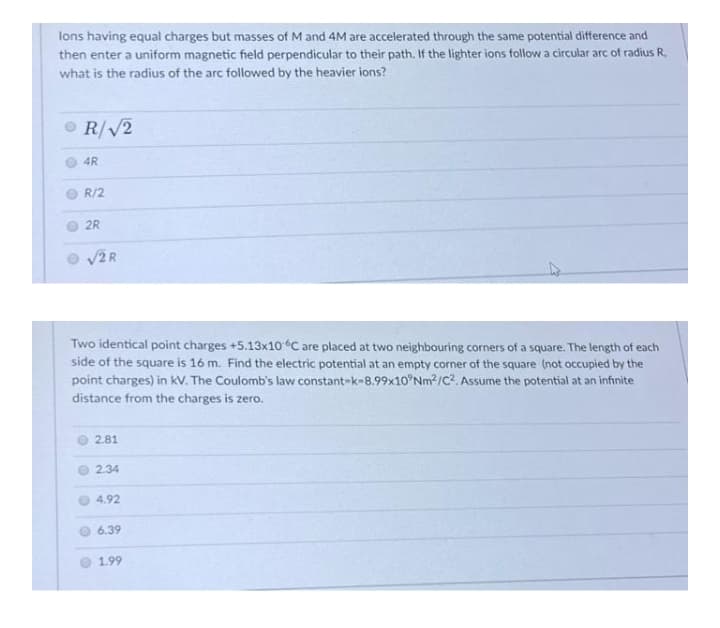lons having equal charges but masses of M and 4M are accelerated through the same potential difference and then enter a uniform magnetic field perpendicular to their path. If the lighter ions follow a circular arc of radius R, what is the radius of the arc followed by the heavier ions? O R/V2 4R R/2 2R V2R Two identical point charges +5.13x10 C are placed at two neighbouring corners of a square. The length of each side of the square is 16 m. Find the electric potential at an empty corner of the square (not occupied by the point charges) in kV. The Coulomb's law constant-k-8.99x10°Nm²/c?. Assume the potential at an infinite distance from the charges is zero. 2.81 2.34 4.92 6.39 1.99
lons having equal charges but masses of M and 4M are accelerated through the same potential difference and then enter a uniform magnetic field perpendicular to their path. If the lighter ions follow a circular arc of radius R, what is the radius of the arc followed by the heavier ions? O R/V2 4R R/2 2R V2R Two identical point charges +5.13x10 C are placed at two neighbouring corners of a square. The length of each side of the square is 16 m. Find the electric potential at an empty corner of the square (not occupied by the point charges) in kV. The Coulomb's law constant-k-8.99x10°Nm²/c?. Assume the potential at an infinite distance from the charges is zero. 2.81 2.34 4.92 6.39 1.99
Principles of Physics: A Calculus-Based Text
5th Edition
ISBN:9781133104261
Author:Raymond A. Serway, John W. Jewett
Publisher:Raymond A. Serway, John W. Jewett
Chapter22: Magnetic Forces And Magnetic Fields
Section: Chapter Questions
Problem 63P
Related questions
Question

Transcribed Image Text:lons having equal charges but masses of M and 4M are accelerated through the same potential difference and
then enter a uniform magnetic field perpendicular to their path. If the lighter ions follow a circular arc of radius R.
what is the radius of the arc followed by the heavier ions?
O R/V2
4R
O R/2
2R
Two identical point charges +5.13×10C are placed at two neighbouring corners of a square. The length of each
side of the square is 16 m. Find the electric potential at an empty corner of the square (not occupied by the
point charges) in kv. The Coulomb's law constant-k-8.99x10°Nm?/C?. Assume the potential at an infinite
distance from the charges is zero.
2.81
2.34
4.92
6.39
1.99
Expert Solution
This question has been solved!
Explore an expertly crafted, step-by-step solution for a thorough understanding of key concepts.
This is a popular solution!
Trending now
This is a popular solution!
Step by step
Solved in 2 steps

Knowledge Booster
Learn more about
Need a deep-dive on the concept behind this application? Look no further. Learn more about this topic, physics and related others by exploring similar questions and additional content below.Recommended textbooks for you

Principles of Physics: A Calculus-Based Text
Physics
ISBN:
9781133104261
Author:
Raymond A. Serway, John W. Jewett
Publisher:
Cengage Learning


Physics for Scientists and Engineers with Modern …
Physics
ISBN:
9781337553292
Author:
Raymond A. Serway, John W. Jewett
Publisher:
Cengage Learning

Principles of Physics: A Calculus-Based Text
Physics
ISBN:
9781133104261
Author:
Raymond A. Serway, John W. Jewett
Publisher:
Cengage Learning


Physics for Scientists and Engineers with Modern …
Physics
ISBN:
9781337553292
Author:
Raymond A. Serway, John W. Jewett
Publisher:
Cengage Learning

Physics for Scientists and Engineers
Physics
ISBN:
9781337553278
Author:
Raymond A. Serway, John W. Jewett
Publisher:
Cengage Learning

College Physics
Physics
ISBN:
9781285737027
Author:
Raymond A. Serway, Chris Vuille
Publisher:
Cengage Learning

College Physics
Physics
ISBN:
9781305952300
Author:
Raymond A. Serway, Chris Vuille
Publisher:
Cengage Learning